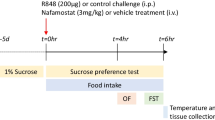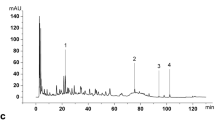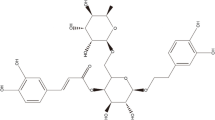Abstract
Objective
To evaluate the effect of Chinese medicine Haoqin Qingdan Decoction (蒿芩清胆汤, HQD) for febrile disease dampness-heat syndrome (FDDHS).
Methods
Forty mice were divided into four groups, including normal control, FDDHS (induced by Radix et Rhizoma Rhei recipe and influenza virus A1 FM1 model), HQD, and the ribavirin groups (10 in each). The normal control and FDDHS groups were administered normal saline. HQD and the ribavirin groups were administered HQD and ribavirin intragastrically once daily at a dose of 64 g/(kg d) and 0.07 g/(kg d), respectively for 7 days. Lethargy, rough hair, diarrhea, tongue color and sole color were evaluated for pathological changes in morphology. The tongue and lung tissues were collected for histology. The CD14 and toll-like receptor 4 (TLR4) expression levels were measured using real-time quantitative polymerase chain reaction.
Results
More than 80% of the FDDHS mice showed hypokinesia and lethargy, and pathological changes associated with rough hair, diarrhea, tongue color and sole color. With advanced treatment for 7 days, the thick greasy tongue fur of the HQD and ribavirin groups were thinner than that of the FDDHS group (P<0.05), and it was the thinnest in the ribavirin group as compared with that in other groups (P<0.05). The CD14 and TLR4 expression levels in the lung tissues of HQD and ribavirin groups significantly delined compared with the model group (P<0.05 or P<0.01). CD14 was down-regulated more remarkably in the HQD group compared with the ribavirin group (P<0.05), whereas the converse was true with TLR4 (P<0.05).
Conclusions
We established a FDDHS mouse model showing systemic clinical symptoms. Both HQD and ribavirin can inhibit the expression of CD14 and TLR4 in FDDHS mice, while the effect of ribavirin might be much more violent. The expression changes of CD14 and TLR4 consistently refers to lipopolysaccharide, the commonly and hotly inducing factor in FDDHS.
Similar content being viewed by others
References
Ren X, Wen X, Hong B, Liao Y, Ma W, Tang Y. Effects of Sanren Decoction on Th1/Th2 cytokines in rats with spleenstomach damp-heat syndrome. J South Med Univ (Chin) 2012;32:181–184.
Wang ZZ, Fang YF, Wang Y, Mu FX, Chen J, Zou QH, et al. Logistic regression analysis of damp-heat and cold-damp impeding syndrome of rheumatoid arthritis: a perspective in Chinese medicine. Chin J Integr Med 2012;18:575–581.
He HH, Shen H, Zheng K. Observation of the curative effect of Qingchang Huashi Recipe for treating active ulcerative colitis of inner-accumulation of damp-heat syndrome. Chin J Integr Tradit West Med (Chin) 2012;32:1598–1601.
Yang CJ, Liu HW, Wang LC. Study on the differential gene expressions of chronic hepatitis B patients of Gan depression Pi deficiency syndrome and Pi-Wei damp-heat syndrome. Chin J Integr Tradit West Med (Chin) 2012;32:1032–1037.
Zhang SJ, Chen Z, Li GW, BL Wang. Effect of the Haoqinqingdan Decoction on damp-heat syndrome in rats with influenza viral pneumonia. Asian Pac J Trop Med 2013;6:653–657.
Ji G, Fan JG, Chen JJ, Lu LG, Xing LJ, Zheng PY, et al. Effectiveness of Danning Tablet in patients with nonalcoholic fatty liver of damp-heat syndrome type: a multicenter randomized controlled trial. J Chin Integr Med 2008;6:128–133.
Pan Y, Luo BD, Lin PZ, Liu Y, Wan WR, Guo JQ. The mechanism of signal extension in Haoqin Qingdan Decoction immunity activity in damp-heat syndrome of pneumonia disease infected by influenza virus. Chin J Prevent Med (Chin) 2010;44:612–616.
Prescott JB, Hall PR, Bondu-Hawkins VS, Ye C, B Hjelle. Early innate immune responses to Sin Nombre hantavirus occur independently of IFN regulatory factor 3, characterized pattern recognition receptors, and viral entry. J Immunol 2007;179:1796–1802.
Zanoni I, Granucci F. Role of CD14 in host protection against infections and in metabolism regulation. Front Cell Infect Microbiol 2013;3:32.
Zanoni I, Ostuni R, Marek LR, Barresi S, Barbalat R, Barton GM, et al. CD14 controls the LPS-induced endocytosis of toll-like receptor 4. Cell 2011;147:868–880.
Kim D, Kim JY. Anti-CD14 antibody reduces LPS responsiveness via TLR4 internalization in human monocytes. Mol Immunol 2013;57:210–215.
Shirey KA, Lai W, Scott AJ, Lipsky M, Mistry P, Pletneva LM, et al. The TLR4 antagonist Eritoran protects mice from lethal influenza infection. Nature 2013;497:498–502.
Imai Y, Kuba K, Neely GG, Yaghubian-Malhami R, Perkmann T, van Loo G, et al. Identification of oxidative stress and toll-like receptor 4 signaling as a key pathway of acute lung injury. Cell 2008;133:235–249.
He LQ. Application of the theory of damp-heat in Spleen and Stomach in treatment of kidney diseases. J Chin Integr Med (Chin) 2004;2:7–9.
Zhang SF, Ling CQ, Li B, Chen HY, Chen Z. Effects of Sisheng Decoction on the immunity and anti-stress function in mice with Spleen deficiency syndrome. J Chin Integr Med 2012;10:1465–1469.
Liang R, Li Y, Wang SH. Analysis on tongue manifestations of 488 cases of Warm disease in Qing Dynasty. Chin J Med History (Chin) 2006;36:131–134.
Xu Y, Zeng CC, Cai XY, Guo RP, Nie G, Jin Y. Chromaticity and optical spectrum colorimetry of the tongue color in different syndromes of primary hepatic carcinoma. J Chin Integr Med (Chin) 2012;10:1263–1271.
Chen Q. Experiences in treatment based on syndrome differentiation for black fur caused by dampness stagnancy due to Spleen deficiency. J Chin Integr Med (Chin) 2006;4:320.
Zhuo YY, Yang ZX, Wu JM. Effect of electroacupuncture on differentiation and proliferation of hippocampal nerve stem cells in splenic asthenia pedo-rats. Acupunc Res (Chin) 2011;36:327–334.
Shi JH, Ding H. Effects of hygrothermal environment on endotoxin induced newzealand rabbit’s liver, colon tumor necrosis factor expression. J Shaanxi Coll Tradit Chin Med (Chin) 2014;37:62–65.
Jue TS, Chang LP, Lv JY, Li SG, Huang LP, Huang P, et al. Effect of modified Huopu Xialing Decoction on TNF-α, IL-10 and blood lipid metabolism of rats with febrile disease damp-heat syndrome (FDDHS). J Guangxi Med Univ (Chin) 2012;29:197–200.
Author information
Authors and Affiliations
Corresponding author
Additional information
Supported by the National Natural Science Foundation for Distinguished Young Scholars of China (No. 81102535)
Rights and permissions
About this article
Cite this article
Luo, Hh., Zhang, Fx., Wu, W. et al. Haoqin Qingdan Decoction (蒿芩清胆汤) and ribavirin therapy downregulate CD14 and toll-like receptor 4 in febrile disease with dampness-heat syndrome in a mouse model. Chin. J. Integr. Med. 22, 768–773 (2016). https://doi.org/10.1007/s11655-016-2097-2
Received:
Published:
Issue Date:
DOI: https://doi.org/10.1007/s11655-016-2097-2




